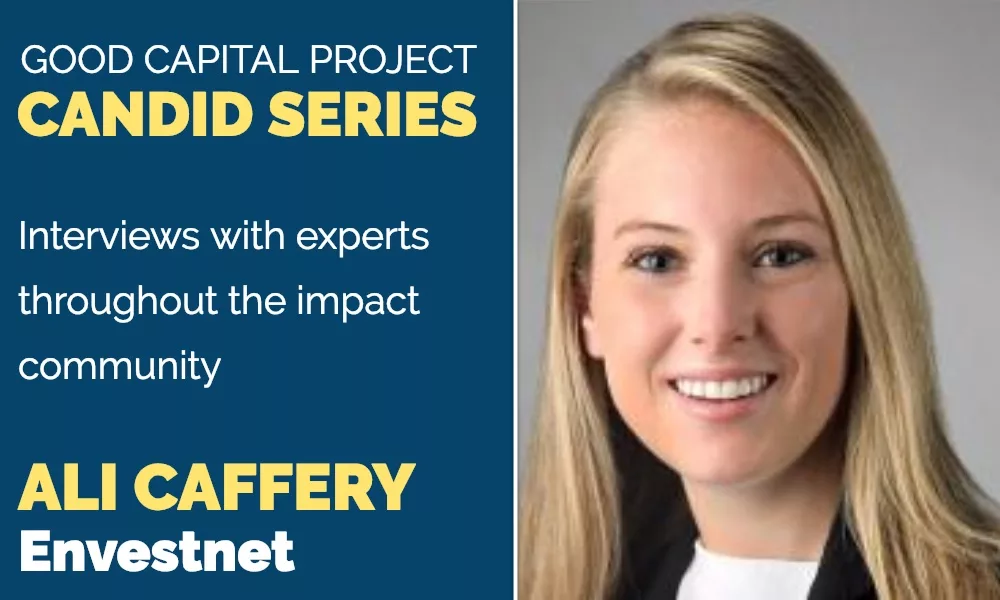
Alexandra (Ali) Caffery is an AVP Portfolio Manager at Envestnet’s Quantitative Research Group. She is responsible for managing the firm’s Quantitative Portfolios. Ms. Caffery also created and launched several strategic initiatives for Envestnet, including an Endowment & Foundations program, which is a series of Impact portfolios focused on incorporating ESG factors, and a Donor Advised Fund capability.
GCP: Can you tell us about Envestnet’s impact focused Quantitative Portfolios?
Ali Caffery: Our goal at Envestnet is to enable advisors to meet their clients’ specific needs and empower them to create deeper and more meaningful relationships. Having impact conversations with clients shows that we care about their money and passions. In general, we see impact as a large opportunity. Envestnet launched a set of Quantitative Portfolios (QPs), which are low cost, index-based portfolios in a separate account format. Our QPs track an underlying index, like the Russell 1000, and attempt to obtain the same risk and return characteristics.
Our QPs help investors obtain diversified beta exposure with a portfolio that aligns with their values at a lower cost than utilizing an active manager. We’re also able to offer further customization in terms of a client’s values, such as screening out additional securities and tax management solutions. To date, we’ve launched three main impact versions – the first offers broad ESG exposure, the second focuses on gender equity, and the third, and most recent version incorporates Catholic values.
GCP: What are the metrics Envestnet uses for incorporating E, S, and G into your strategies?
AC: We selected partners who are well-known in their space to help us with ESG strategies and leveraged them based on their individual expertise. Envestnet partners with Sustainalytics, which is a leading provider of ESG data and research. They provided a framework for how we select securities in the ESG and Gender Equity portfolios. We also partnered with Dana Investment Advisors, a leader in providing mission-aligned portfolios, to help develop strategies for the Catholic values portfolio.
Within each of the ESG categories, we look at multiple dimensions. When looking at sustainability, we actively monitor any companies facing controversies. Sustainalytics scans thousands of investment and news sources on a daily basis. In examining the ‘E’ or environmental factor, we might look at a company’s carbon footprint, which contributes to their overall carbon score versus their peers. For governance, we’re looking at company accounting practices, transparency of their reporting, board diversity, and overall leadership composition.
GCP: Can you share a few examples of ESG impacts you have been able to track from Envestnet’s Quantitative Portfolio series?
AC: Using Sustainalytics percentile scoring, our Gender Equity QP has an average diversity score of 56 versus 39 for the Russell 1000 Index, which indicates there is a strong emphasis on companies with good diversity.
One example of the individual portfolio constituents is Cisco, which is a U.S. based technology company in the consumer staples sector. They have been recognized as one of the best companies to work for as a woman. About 33% of their board members are women, five out of 14 executives are women, and they were one of the founding signers of the White House Equal Pay Pledge, which focuses on making fair pay a reality for all employees in the US. We specifically seek out companies with these factors and policies to incorporate in our portfolio.
We’re currently working with Sustainalytics on the next QP, a fossil-free portfolio, which will be available in 2019. Sustainalytics came out with robust metrics on carbon footprints, which is particularly interesting to me. I respect the environment and climate change is something we will help mitigate using this portfolio.
GCP: It’s been a little over a year since Envestnet launched the Gender Equity QP – tell us about the gender-lens strategy.
AC: We launched the Gender Equity QP in response to a growing passion in investors wanting to take advantage of this investment opportunity. A study published by Morgan Stanley found firms with higher returns on equity, compared to their peers, tended to have more diverse management teams.
There’s a growing body of research pointing to gender diversity on boards and in leadership positions as a driver of financial performance, leading us to believe there is an overall alpha thesis correlated to gender diversity. Our strategy emphasizes gender equality, diversity, and overall ESG principles in the companies. We’re looking at factors such as having a diverse board composition, diversity programs, and policies creating opportunities for women.
GCP: Considering your experience working with foundations, what’s the motivation behind foundations and endowments moving to more mission-aligned investments? How are they getting buy-in from investment committees?
AC: Institutions, including endowments and foundations, are facing a lot pressure to move towards values-based investments. Investors, board members, and donors see impact investment approaches as a way to create mission-alignment within portfolios and bring new donors into their asset base. In our experience, foundations are ahead of the curve in understanding the benefits of ESG investing and as a result, investment committees have been eager to move forward with these strategies. Our impact suite of Quantitative Portfolios have been a particular interest to foundations because they want to maximize their ability to make grants. With this portfolio, foundations are able to customize what they don’t want to hold and include themes important to their mission in a low-cost way.
GCP: What combination of strategies is being used to maximize financial and impact objectives for foundations?
AC: We believe our Quantitative Portfolios are on the forefront of impact investing for equity asset classes. We pair our QPs with an active fixed income component. We are typically delivering a total portfolio solution, meaning we need to think about equities, diversifying asset classes, and fixed income to make sure the portfolio meets the investment goals of the foundation.
Our strategy has resonated with foundations in terms of pairing low-cost equity solutions with an active impact focused fixed income manager. This has provided opportunities for them to gain access to more high impact areas, like affordable housing or green bonds.



